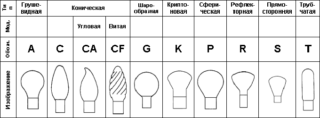Lighting plays a huge role in interior design. Natural light is usually not enough, so artificial sources are installed. LED devices are very popular. With their help, you can create unique lighting systems and favorably emphasize the style of the room.
Advantages and disadvantages
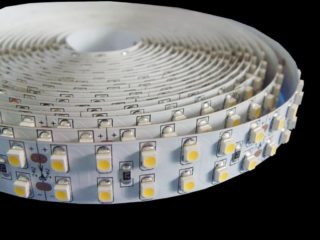
A light-emitting diode is a semiconductor device that produces a glow when an electric current is applied. The scope of these devices is huge. LEDs are actively used in lighting fixtures, computer monitors and televisions, smartphones, traffic lights.
LED technology has appeared on the market relatively recently. However, diode lamps have been able to gain immense popularity among consumers. This is due to the advantages that semiconductor lighting devices have. The pluses include:
- Low power consumption. LEDs need 70% less electricity than classic bulbs.
- Long service life. Subject to the operating conditions and the correct development of the power supply circuit, the luminaire will work for more than 50 thousand hours.
- Resistant to mechanical damage and vibration. The bulb is made of durable material, there is no fragile filament inside.
- Flicker-free.
- Minimum heating. All energy turns into light.
- Ease of installation.
- Environmental friendliness. There are no harmful elements inside the lamp. Due to this, they do not require special disposal conditions.
A significant disadvantage of LED products is their high cost. A good device can cost you 2,000 rubles. You can buy a cheap light bulb for 100 rubles, but it will not last long.
Types of LED lighting
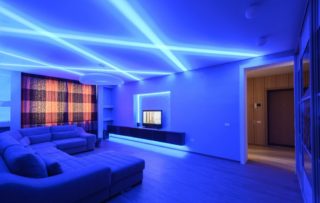
The lighting of an apartment is different depending on several criteria: the size of the room, its purpose, the interior, the need for zoning, the purpose of the lighting. According to these parameters, the optimal type of lighting is selected.
The following main types can be distinguished:
- Diffused artificial ice lighting. This backlight is the main light source. From LED fixtures, lighting evenly fills the entire space. With a device of this type of backlight, unlit areas should not be allowed to appear.
- Work light. It is used for zoning a room. Light bulbs are placed in areas where bright lighting is needed - usually work areas, for example, where food is prepared or where a child is doing homework.
- Accent light. With its help, you can focus a person's gaze on a piece of furniture or an area of a room.
- Decorative light. Emphasizes the aesthetic aspect of the room. With proper placement, it can expand the room, visually enlarge the ceilings.
All types of lighting are created using different types of lamps.
The main types of lamps
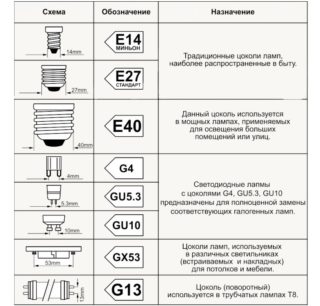
Lighting manufacturers produce products with different characteristics. These parameters should be understood before buying light bulbs.
There is no strict classification of lamps, but conditionally LED light sources can be divided into several large categories:
- By the type of source used.There are lamps that use SMD LEDs, COB models with a uniform light distribution, super-power diodes.
- At the place of installation. Allocate street lamps and products for indoor use.
- By the type of base. Available with standard E27, E14, G5,3, G10 and others.
- By form. There are bulbs in the form of a pear, candle, oval, circle and other geometric shapes.
- By the presence of a cooling radiator.
- By the brightness of the glow.
- By power.
- By color temperature.
Particular attention is paid to the manufacturer. In order for the lamp to comply with the declared characteristics, it must be made of high-quality materials; accordingly, such a device will not be cheap. Manufacturers of unknown origin can save on circuit elements, which will cause malfunctions during lamp operation.
Types of lamps and their application
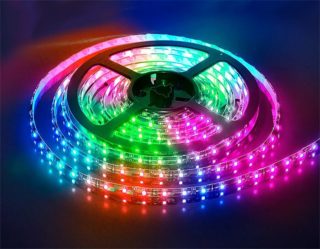
In the house, you can make lighting in different ways. For example, highlight work areas, create general lighting, illuminate paintings and mirrors. Different lamps are responsible for the implementation of each type of lighting. They have their own characteristics and characteristics.
LED strips
Structurally, this type of luminaire is a flexible board on which LEDs and resistors are applied. Strip lighting is used where other light sources cannot be supplied. Often, using tape, they emphasize the beauty of multi-level ceilings. The tape is attached along the perimeter of one or several levels, it can be of different colors.
Also tapes are attached to furniture, paintings, mirrors. It can be installed in a long hallway on the lower part of the wall, and if you use motion sensors, such a structure will automatically be triggered when a person appears. This will ensure the safety of movement at night.
Chandelier
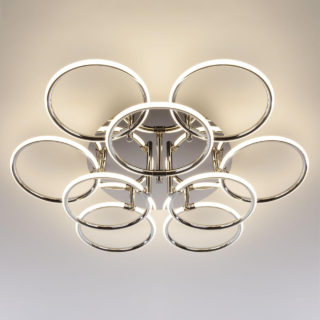
LED chandeliers are like ordinary ceiling lights. The body is made of different materials - metals, plastic, glass. They also vary in style. For a large living room with high ceilings, a classic-style product with hanging elements is suitable. For an eco-style room, you can pick up a chandelier made of natural materials - bamboo, fabric, glass. If you need a chandelier in the kitchen, you can find the product in a waterproof case.
Some models may have a remote control. Such devices are convenient for people with limited mobility. Devices with a dimmer are popular, in which you can control the brightness of the glow.
Advantages of LED chandeliers:
- A wide range of.
- The ability to control the intensity.
- Can be installed on stretch ceilings.
- Create even lighting.
Ceiling chandeliers can create a pleasant atmosphere in the room and accentuate the style of the room.
Led panels
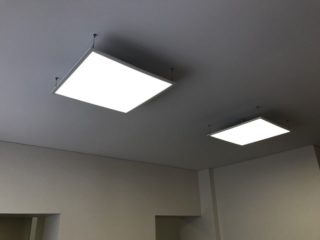
LED panels are installed in large rooms. They are suspended and recessed. Round, rectangular and square panels are distinguished in shape. The thickness is 14-15 mm.
The panels are available with or without shades. Some models have backlight brightness and color control.
Stand-alone luminaires with motion sensor
For local intermittent illumination, devices on batteries or rechargeable batteries with a motion sensor can be used. The lamp lights up when a person enters the room. Such devices can be placed in the attic, in the garage, in the corridor or in the bathroom. The backlight range depends on the characteristics of the light bulb. The advantages include compactness, ease of installation and bright light.
Optimal lighting in different rooms
When creating lighting in the house, the main rule is the harmony of the location of the lamps. A bulky chandelier will look ridiculous in a small room, so you need to think in advance about which light sources you should buy. In each room, depending on the purpose, its own layout is created.
Living room
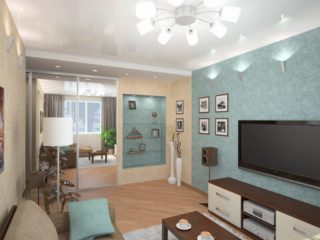
The hall or living room is the most spacious room in the entire apartment. They spend time with their family here, meet guests, so there should be a lot of light in the living room. The classic version of a backlit room is the installation of a central LED chandelier, several lamps around the perimeter of the room and on the walls.
There are more sophisticated ways to organize lighting. For the living room, 3 types of lighting are used in the interior:
- General. It can be either with or without a chandelier. LED sources are evenly spaced around the perimeter of the room.
- Working. LED strip can be used to illuminate the recreation area, sconces are placed next to the coffee table, wall lamps are mounted in the ceiling.
- Decorative. Light frames decorative elements, paintings, mirrors, shelves, cornices.
When using multi-level ceilings, LED lighting is used in the room using tape or spotlights. They allow you to visually make the hall more spacious, and the ceilings are higher. Can be installed in skirting boards.
Bedroom
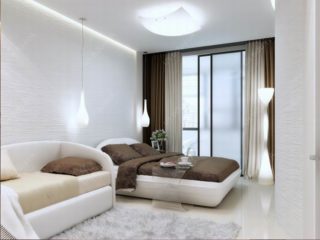
The break room is a place for which you need to carefully select the lighting. In the bedroom, the lighting should be soft, relaxing, and conducive to falling asleep quickly. In the bedroom, you can put main and additional light sources.
In a small room in the center, you can put a miniature overhead or built-in chandelier. The bedside area is designed separately using wall sconces, beautiful floor lamps. The backlighting with LED strip under the bed looks original. Also neon flexible strips, tubes with LEDs are used, strips can be installed in polyurethane or aluminum profiles.
We need to make light in the dressing room. You can hang several miniature wall lamps in it.
Children
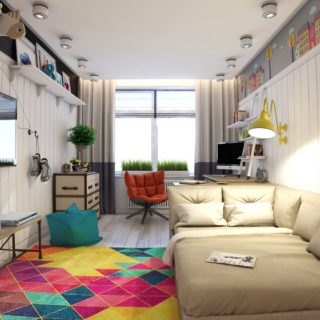
The room for children is designed according to the age of the child. The room should be divided into several zones - a play area, a sleeping place and a work area. Bright LEDs with a uniform glow should be installed in the room. On the ceiling, you can hang a central chandelier in the shape of stars, animals or with another original shade. You can also put an ice panel and spotlights. In the children's room, they often make original ceiling lighting using point LEDs and photo printing. It can be a starry sky, ornamental lighting.
The desktop must be highlighted. For this, table lamps and wall lamps are used. A night light is placed next to the bed on the wall or cabinet. For the game part, you can design an original lighting using a tape.
Kitchen
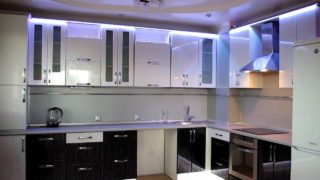
Usually the kitchen space is small in size. There are several zones in the kitchen that need to be visually divided. General lighting is organized using compact ceiling lamps or pendant chandeliers. Powerful ice lamps with cold light can be placed on the work area.
Ribbon lighting is often used in the kitchen. It can be fixed in niches, above shelves, under glass. The tape can also be installed on furniture - for example, along the contour of the table top. On sale you can find ready-made kitchen furniture with light sources installed in it.
A bright light is needed above the dining table. One or more pendant chandeliers can give it. If the kitchen has a bar counter, it can also be illuminated using original pendant light sources.
Corridor
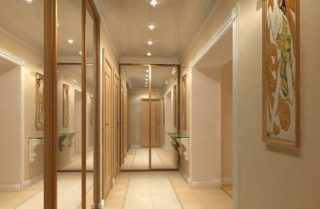
An entrance hall is a room that does not have natural light sources. All lighting is created by luminaires only. The location of the lamps depends on the size of the room.
In a long, narrow hallway with a high ceiling, the light can be centered in one or two lines. You can hang ice tape around the perimeter to expand the space. If the ceilings are low, sconces are hung on the walls, in which you can change the direction of light.Typically, indoor LED lighting lamps are directed upward to visually enlarge the ceilings.
Sconces are also hung next to the mirrors. If the mirror is large, you can hang two lights around the edges. Instead of a sconce, you can use a ribbon.
Lamps in the hallway must be powerful. When moving from one room to another, contrast should not be felt.
Bathroom
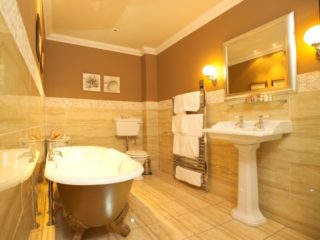
The bathroom is a room with a difficult microclimate. There is high humidity here, so the main requirement for lamps is moisture resistance.
Usually, LED spotlights are evenly placed on the ceiling in the bathroom. In addition, functional areas are highlighted - a sink, a mirror. For this, sconces are used in a waterproof case.
Original lighting ideas
Simplicity, wide range of colors and flexibility of LED light sources allow realizing the most original designs. With their help, you can decorate the window space - make a hidden curtain backlighting. If the house has arches and niches, you can place lamps along the contour. Ribbons can illuminate plants, aquariums, bookshelves.
There are a huge number of ideas and solutions for lighting using LEDs. But you need to follow the rule - LED lighting in the apartment should be uniform and bright.

